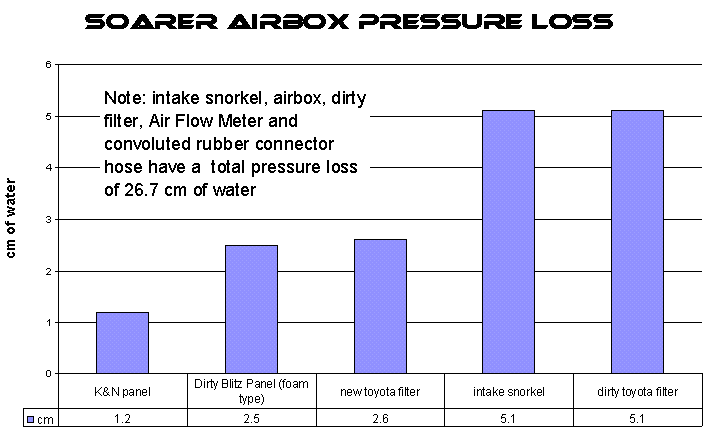![]()
October 20001
These are maximum pressure losses recorded in a V8 Soarer. The car was in 2nd gear with the ECT POWER switch on. This gives nice even acceleration so that the U-tube manometer doesn't bounce around. The throttle was wide open and the maximum vacuum recorded (usually at 110 km/hr). The test was then repeated in front of the filter to calculate the pressure drop across the filter. A nice new looking K&N panel drop in filter ($180), a dirty Blitz panel filter (1 year old), and new Toyota filter (and a dirty one) were tested. A K&N pod was also tested and was a bit better than the drop in panel filter. The standard intake snorkel was also tested and is here for a comparison.
The biggest restriction is the standard intake snorkel - it is the most effective single thing you can do to the standard airbox.
New Toyota filter, remove snorkel = 28.5% total improvement
New K&N filter, remove snorkel = 33.7 % improvement.
Note: this is not a % improvement in flow or horsepower - only % improvement in pressure drop (a completely different thing).
The percent improvement improves dramatically if you have a TT or 3.0 L as they don't have Air Flow Meters (AFM's).
The K&N has about a 50% less pressure drop across it. But since the Toyota filter already has a small pressure drop, it is 50 % of a small number. The gain of 1.4 cm of water (or 0.5 inches) is a small gain. If it results in a measurable gain in horsepower then removing the standard intake snorkel will give 3.5 times the horsepower increase. Other things to consider are filtration and price.


old filter next to a new one - what colour is yours? New genuine part is 17801-46060 (lexus/toyota) - cost about $50. Wesfil (non genuine) filter number WA984 - cost about $30
Stock one flows better on the dyno.

intake snorkel and airbox. Headlight has to come out to remove snorkel - airbox hole is too small for full flow. This is a TT airbox - different rear shape to V8.
On high horsepower engines I have seen improvements of 1-2 kW, but they never say over what. Is it a 1-2kW improvement over a brand new stock filter or the old dirty one? When people buy a new after market high performance filter they rarely buy a new stock one as well and compare the two. More often than not they take out the old dirty one, whack in the new one and report big improvements. I still remember the AutoSpeed article where on the dyno the K&N gave no measurable improvements. It must give some improvement - just not much. The filtration is also a concern - haven't seen one independent test where any filter matched a stock one.
Perhaps you could fit one and do an oil analysis to monitor how much dirt was entering the engine. Perhaps you figure the car will be gone before any measurable effects will be noticed. Would you buy a car with an after-market filter?
The first function of the filter is to filter - the stock one has a small pressure drop penalty but I doubt I could tell the difference. My brother owns a auto parts store - I can have any filter I want. My choice is the standard Toyota filter.
At the next Australian Lexus Soarer Club dyno day (genuine filter made the most power!) this will be one of the items we can investigate for ourselves - how much difference does it make on the dyno in a Soarer? I'll bring a new filter to find out. And also see how the old one is going as the kilometers mount up. I'll measure the pressure drop across the standard filter every 5k when the oil test is done to see how things go. If you have any filter stories to share please email them to me.
Back to SOARER tech stuff (well now it's called Planet Soarer!)